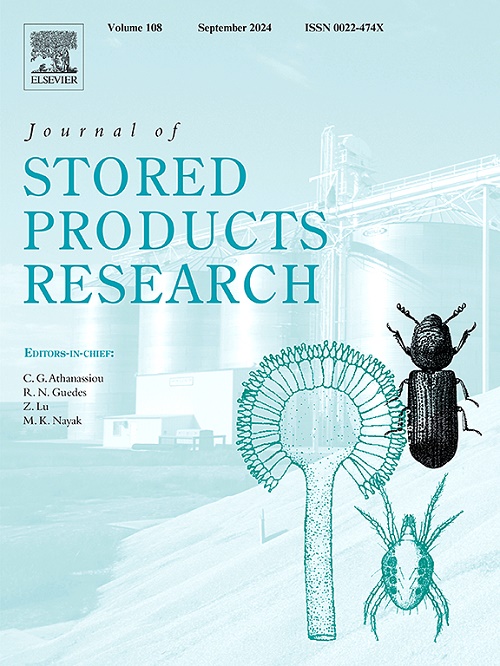Deltamethrin, spinetoram and their combinations alter heat tolerance in Sitophilus oryzae (Coleoptera: Curculionidae) and Tribolium castaneum (Coleoptera: Tenebrionidae) adults
IF 2.7
2区 农林科学
Q1 ENTOMOLOGY
引用次数: 0
Abstract
Sitophilus oryzae and Tribolium castaneum are serious pests of stored food. Insecticides are effective management tools but have many drawbacks. The exposure to bacterial formulation spinetoram, pyrethroid deltamethrin and high temperature are effective treatments but their effects on certain species when used alone or in combination are poorly understood. This study evaluated the single and combined effects of spinetoram, deltamethrin and heat on the mortality of S. oryzae and T. castaneum adults. The adults were exposed prior to deltamethrin alone or deltamethrin + spinetoram combinations. Subsequently, the insects were held at 42°C and 46°C, respectively. Insect mortality at different durations was performed to calculate a LT50. Without exposure to heat, deltamethrin + spinetoram combination caused higher mortality than deltamethrin alone in S. oryzae but not in T. castaneum. Increased duration at high temperature increased the mortality in both species. The heat tolerance (LT50) was reduced in S. oryzae when exposed prior either to deltamethrin alone or deltamethrin + spinetoram combination, at all the concentrations tested. However, T. castaneum adults exhibited reduced heat tolerance at 15 ppm either with deltamethrin alone or deltamethrin + spinetoram. In general, prior exposure to deltamethrin + spinetoram additively induced mortality and reduced the survival at high temperature compared to deltamethrin alone in S. oryzae but not in T. castaneum. We conclude that prior exposure to deltamethrin and spinetoram may reduce heat tolerance enabling pest management at shorter exposure durations and thereby also lowering heat energy costs. Future experiments should address the limitations identified in this study for improvements to management and to assess the success under field settings.
溴氰菊酯、刺螨灵及其复方可改变米象(鞘翅目:斑甲科)和黄斑拟虫(鞘翅目:拟甲科)成虫的耐热性
米象和栗僵虫是储粮中的严重害虫。杀虫剂是有效的管理工具,但也有许多缺点。接触细菌制剂spinetoram、拟除虫菊酯、溴氰菊酯和高温是有效的治疗方法,但它们单独或联合使用对某些物种的影响尚不清楚。本研究评价了spinetoram、溴氰菊酯和高温对稻瘟病病菌和castaneum成虫死亡率的单独和联合影响。在单独使用溴氰菊酯或溴氰菊酯+ spinetoram联合使用之前,对成虫进行暴露。随后,将昆虫分别保存在42°C和46°C。采用不同持续时间的昆虫死亡率计算LT50。在不受热的情况下,溴氰菊酯+棘虫啉联用对稻瘟病菌的死亡率高于单用溴氰菊酯,而对稻瘟菌的死亡率低于单用溴氰菊酯。高温持续时间的增加增加了两种植物的死亡率。在不同浓度的溴氰菊酯单独或溴氰菊酯+ spinetoram组合处理前,稻瘟病菌的耐热性(LT50)均有所降低。然而,在15 ppm浓度下,无论是单独使用溴氰菊酯还是使用溴氰菊酯+ spinetoram, castaneum成虫的耐热性都有所降低。总体而言,与单独使用溴氰菊酯相比,先前暴露于溴氰菊酯+棘虫虫胺可导致稻瘟病菌在高温下的死亡率和存活率降低,而在castaneum中则没有。我们的结论是,先前暴露于溴氰菊酯和spinetoram可能会降低耐热性,从而使害虫在更短的暴露时间内进行管理,从而降低热能成本。未来的实验应解决本研究中确定的局限性,以改进管理并评估实地环境下的成功。
本文章由计算机程序翻译,如有差异,请以英文原文为准。
求助全文
约1分钟内获得全文
求助全文
来源期刊
CiteScore
5.70
自引率
18.50%
发文量
112
审稿时长
45 days
期刊介绍:
The Journal of Stored Products Research provides an international medium for the publication of both reviews and original results from laboratory and field studies on the preservation and safety of stored products, notably food stocks, covering storage-related problems from the producer through the supply chain to the consumer. Stored products are characterised by having relatively low moisture content and include raw and semi-processed foods, animal feedstuffs, and a range of other durable items, including materials such as clothing or museum artefacts.

 求助内容:
求助内容: 应助结果提醒方式:
应助结果提醒方式:


